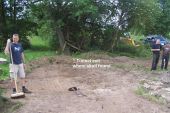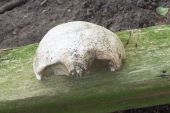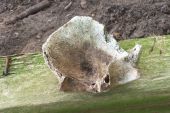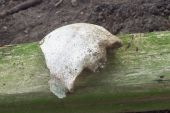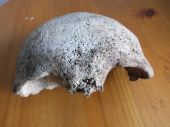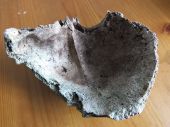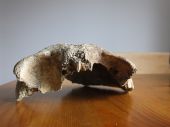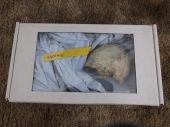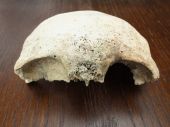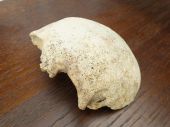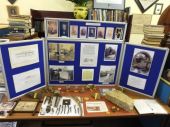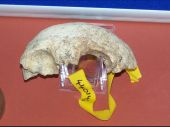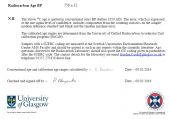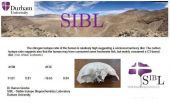One of the most fascinating finds has been the frontal bone of a human skull. It has always been said that human bones from Hamburg, Germany were exhumed from graveyards and used at the mill but there was speculation about whether this was true. This find suggests human bones were used as well as whale and animal bones.
The skull bone was found on 27 June 2015 by Graeme Brown when digging out the down-river exit of the tunnel. It was found near the top of the earth filling the tunnel exit, so excavation stopped in this area, as we needed to preserve the site for potential forensic investigation. As the discovery was towards the end of the working day the Project Manager was informed of the find and he notified the Police who visited the site and took the skull bone away for examination.
After around two weeks we were informed that tests carried out confirmed it was human and that it had been buried for over 70 years. This meant the Police did not need to investigate, so we had the skull back and put it on display in the Heritage Centre. The skull is believed to be from a young woman.
Dealing with human remains is always difficult, on one hand we are interested in all the finds and want to display and examine them, but we are very much aware that this was once a person and need to be respectful of that. Before deciding what to do we considered such things as whether burial rites would have been performed at the time of their death, we felt this would have been the case, and whether the individual could be traced, which they could not.
We sent the skull for Radiocarbon dating and the results were received on 12/02/16. It dates the skull to around 759 years old (+/-32 yrs) which pre-dates the mill by several centuries, making it likely that it was among exhumed bones from Germany. So this person would have lived in about 1257 when Henry lll or Edward l were on the throne in England, but the skull is believed to be from a young woman buried in Hamburg.
In Germany in 1257, Richard of Cornwall was elected King of Germany, Rudolf l of Habsburg was born in 1218, he was King of Germany from 1273 to 1291. Hamburg and Lubeck formed an alliance in 1241 which eventually became the Hanseatic League which Kings Lynn (known then as Bishop's Lynn) was a member. In 1284 there was a great fire in Hamburg which destroyed most of the city.
Dennis made a wooden display box for the skull with a Perspex cover and it is now on display in the visitor centre at the mill. Lights have now been added to the display cabinet, giving a better view of the skull bone.
In November 2016 the skull was sent for isotope analysis which suggests an omnivore / carnivore diet and they may also have consumed some freshwater fish but eat mainly a C3 diet (rice, wheat, soybeans). We had hoped the results would indicate where the person lived, to confirm if they were German, but this information was not provided.
In August 2021 we looked into DNA testing to find out if hair and eye colour could be found, and where in the world the person was from. We were advised that its very unlikely enough Nuclear DNA would be available in this type and age of bone. Bearing this in mind with the high cost (£1,000) we decided not to pursue this at the moment, but with constant advances in DNA science, we may consider it in the future.
Graham Bartlett Interactive Plan EDP Skull Article EDP HLF Article


